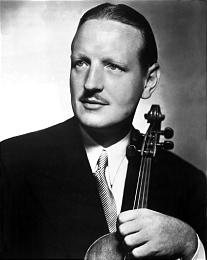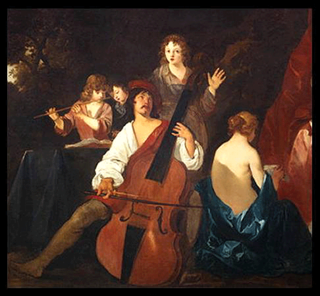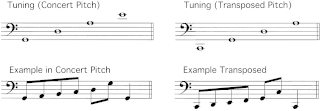
The violoncello ( VY-ə-lən-CHEL-oh, Italian pronunciation:[vjolonˈtʃɛllo]), normally simply abbreviated as cello ( CHEL-oh), is a middle pitched bowed (sometimes plucked and occasionally hit) string instrument of the violin family. Its four strings are usually tuned in perfect fifths: from low to high, C2, G2, D3 and A3. The viola's four strings are each an octave higher. Music for the cello is generally written in the bass clef, tenor clef, alto clef and treble clef used for higher-range passages.

The double bass, also known as the upright bass, the acoustic bass, the bull fiddle, or simply the bass, is the largest and lowest-pitched chordophone in the modern symphony orchestra. It has four or five strings, and its construction is in between that of the gamba and the violin family.

In music, there are two common meanings for tuning:

The viola ( vee-OH-lə, Italian:[ˈvjɔːla,viˈɔːla]) is a string instrument of the violin family, and is usually bowed when played. Violas are slightly larger than violins, and have a lower and deeper sound. Since the 18th century, it has been the middle or alto voice of the violin family, between the violin (which is tuned a perfect fifth higher) and the cello (which is tuned an octave lower). The strings from low to high are typically tuned to C3, G3, D4, and A4.

Pizzicato is a playing technique that involves plucking the strings of a string instrument. The exact technique varies somewhat depending on the type of instrument:

Scordatura is a tuning of a string instrument that is different from the normal, standard tuning. It typically attempts to allow special effects or unusual chords or timbre, or to make certain passages easier to play. It is common to notate the finger position as if played in regular tuning, while the actual pitch resulting is altered. When all the strings are tuned by the same interval up or down, as in the case of the viola in Mozart's Sinfonia Concertante for Violin, Viola and Orchestra, the part is transposed as a whole.

The violin octet is a family of stringed instruments developed in the 20th century primarily under the direction of the American luthier Carleen Hutchins. Each instrument is based directly on the traditional violin and shares its acoustical properties, with the goal of a richer and more homogeneous sound. Unlike the standard modern stringed instruments, the main resonance of the body of the violin octet instrument is at a pitch near the two middle open strings, giving the instruments a more balanced, clearer sound.

Carleen Maley Hutchins was an American high school science teacher, violinmaker and researcher, best known for her creation, in the 1950s/60s, of a family of eight proportionally-sized violins now known as the violin octet and for a considerable body of research into the acoustics of violins. She was born in Springfield, Massachusetts and worked at her home in Montclair, New Jersey.

The Viola Concerto, Sz. 120, BB 128 was one of the last pieces Béla Bartók wrote. He began composing it while living in Saranac Lake, New York, in July 1945. It was commissioned by William Primrose, a respected violist who knew that Bartók could provide a challenging piece for him to perform. He said that Bartók should not "feel in any way proscribed by the apparent technical limitations of the instrument". Bartók was suffering the terminal stages of leukemia when he began writing the piece and left only sketches at the time of his death.

The term violone can refer to several distinct large, bowed musical instruments which belong to either the viol or violin family. The violone is sometimes a fretted instrument, and may have six, five, four, or even only three strings. The violone is also not always a contrabass instrument. In modern parlance, one usually tries to clarify the 'type' of violone by adding a qualifier based on the tuning or on geography, or by using other terms that have a more precise connotation. The term violone may be used correctly to describe many different instruments, yet distinguishing among these types can be difficult, especially for those not familiar with the historical instruments of the viol and violin families and their respective variations in tuning.

In music, an octet is a musical ensemble consisting of eight instruments or voices, or a musical composition written for such an ensemble.

Violin acoustics is an area of study within musical acoustics concerned with how the sound of a violin is created as the result of interactions between its many parts. These acoustic qualities are similar to those of other members of the violin family, such as the viola.
This is a list of pages with repertoire for string instruments.

The string section of an orchestra is composed of bowed instruments belonging to the violin family. It normally consists of first and second violins, violas, cellos, and double basses. It is the most numerous group in the standard orchestra. In discussions of the instrumentation of a musical work, the phrase "the strings" or "and strings" is used to indicate a string section as just defined. An orchestra consisting solely of a string section is called a string orchestra. Smaller string sections are sometimes used in jazz, pop, and rock music and in the pit orchestras of musical theatre.

A tenor violin (or tenor viola) is an instrument with a range between those of the cello and the viola. An earlier development of the evolution of the violin family of instruments, the instrument is not standard in the modern symphony orchestra. Its tuning, typically G2-D3-A3-E4 (an octave below the regular violin) places the range between the cello and viola and thus is sometimes confused with the modern baritone violin which has the same tuning on the standard violin body.
The Melos Ensemble is a group of musicians who started in 1950 in London to play chamber music in mixed instrumentation of string instruments, wind instruments and others. Benjamin Britten composed the chamber music for his War Requiem for the Melos Ensemble and conducted the group in the first performance in Coventry.
A double concerto is a concerto featuring two performers—as opposed to the usual single performer, in the solo role. The two performers' instruments may be of the same type, as in Bach's Double Violin Concerto, or different, as in Brahms's Concerto for Violin, Cello and Orchestra.

Vilde Frang Bjærke is a Norwegian classical violinist.

The Octet for strings in C major, Op. 7, is an octet composition for string instruments by the Romanian composer George Enescu, completed in 1900. Together with the Octet in F major, Op. 17 (1849) by Niels Gade, it is regarded as amongst the most notable successors to Felix Mendelssohn's celebrated Octet, Op. 20.















